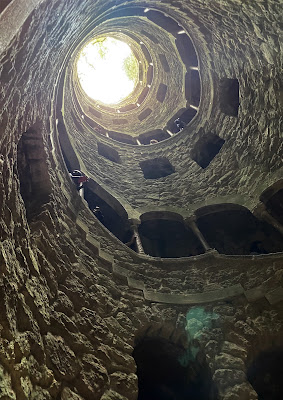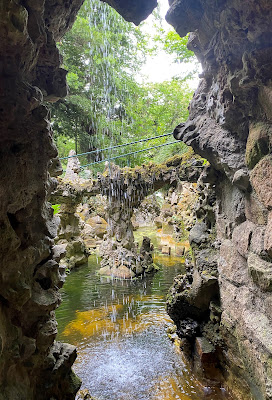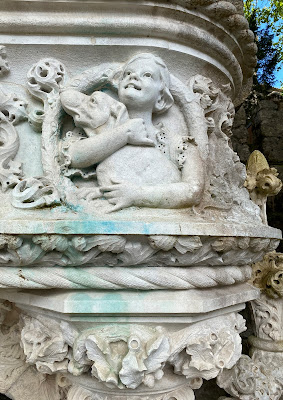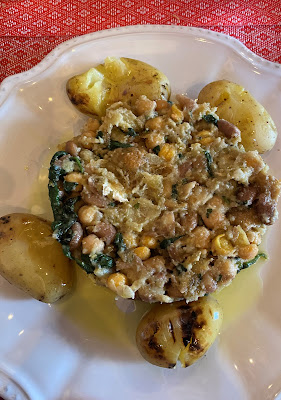June 23, 2022
Our second stop in Sintra was a large property called Quinta da Regaleira. In Portugal, a quinta is a large, primarily rural estate, especially one with a luxurious mansion or palace. The 10-acre property comprises steep hills and a warren of roads, footpaths, stairways, and tunnels that make it seem far larger than it is.
Our guide Filipa dropped our group of eight at the top of the property, gave us general guidelines and directions, and told us when to meet her at the bottom of the hill near the palace. We set out as a group and stayed together as we made our way through the luxuriant forests and gardens that were designed and created by Carvalho Monteiro, an eccentric Brazilian-Portuguese businessman, collector, and book lover who bought the property from the Viscountess of Regaleira in 1892. Between 1904 and 1910 and with the aid of Italian architect Luigi Manini, Monteiro created a dazzling and enigmatic estate that paid tribute to his varied interests. After 1942, the property changed hands several times, finally being acquired by the Sintra Town Council in 1997, which opened it to the public the following year. The property and castle are a key part of Sintra's designation as a UNESCO World Heritage Site
Given our time constraints, we couldn't do the exquisite gardens justice. This is a place that needs repeated visits and free exploration. However, what we did see was extraordinary. I would like to have met the two men whose imagination led to the creation of this park.
Towers and turrets along the way were not only good for photos, but provided less-obstructed views of the surrounding forest.
If you look very carefully at the photo on the above right, you'll see the Moorish Castle that we could see from the Sintra Pena Palace wall walk. Here's a zoomed-in version:I've also learned that although the structure looks like a well, it was never used as one. Rather, Monteiro, a freemason, intended it be used for initiation rites--hence, the name. A mystic aura definitely permeates the place.
The tiled floor of the well is an eight-pointed star, which has all kinds of mythical and religious meanings.
Once you've gone down 88 feet, you aren't too anxious to climb back up the same spiral staircase. Lucky for tourists, the well makes good use of the hill the property includes, and there is an interesting exit from the bottom. First, a tunnel from the bottom of the well leads to the light source: a view of a grotto from behind a waterfall. A much longer segment of the tunnel twists and turns to the exit through what we thought was a natural passageway but turned out to be manmade from sea rocksa. At least it wasn't concrete!
Sintra has more than its share of turrets and spires, castles and palaces.
Speaking of spires and palaces, check out this exquisite neo-gothic palace rising from the forest. Designed by the aforementioned Italian architect and set designer Luigi Manini, this grand house was completed in 1911.
The king and queen were happy to pose for a photo.
There is a separate chapel near the house, and I can't remember why we didn't go inside. Maybe it was closed.
On a different hill in the far distance we could just make out Pena Palace.
Time to go inside the Quinta da Regaleira Palace. The ornate entrance seems to say, "Don't touch. Everything inside is expensive."
I can't remember if this was a knocker or just a decoration, but it is one of my favorite door ornaments of all time. I want a door guardian like this.
He is the kindler, gentler version of Gandalf in Tolkien's Lord of the Rings:
Each room was fully and extravagantly decorated. I wonder if this chair was where the father sat when suitors came by to pick up one of his daughters for a date. It definitely says "Don't mess with the boss."
The ceilings were different in each room:
Okay, another door ornament that I covet. I especially like how the lion is sticking out his tongue.
We had a great view of the elaborate gardens from the upper floors of the palace.
We also enjoyed strolling through some of the grounds around the palace once we were back outside.
All that walking and gawking made us hungry. Filipa dropped us off in the center of town and gave us a few restaurant recommendations.
We chose Restaurant Tulhas, established in 1982, and we were so glad we did!
The ambiance reminded me of an upscale hunting lodge.
We started with a large dish of olives (automatic in many restaurants in Portugal unless you say no, and they do charge you for it) and rolls with delicious sardine paté.
We split two entrées. The first was the famous (and ubiquitous) Portuguese standard, bacalhau, or cod. Supposedly Portugal has something like 350 official ways of preparing bacalhau. This version was shredded cod mixed with chickpeas and formed into a large patty. It was good, but not as good as the grilled octopus, which Bob declared was the best he's ever eaten, even better than what we had eaten in Lisbon.
Dessert was a super light creamy cheesecake with a wild berry sauce. The stuff that dreams are made of.
One dessert is never enough, so we stopped at a bakery and bought a "pillow pastry" and a brigadeiro, a treat I had about 10 of in the Iguazu Falls airport on our Covid-aborted trip to Argentina.
Heavenly.



.JPG)

.JPG)













.JPG)
.JPG)






.JPG)





.JPG)










.JPG)





.JPG)


.JPG)

I liked the circular drop into the well, the highlight for me (the highlight of Pena Palace was the view of the surrounding area). The food in Sintra was one of my favorites on the trip. The ambiance was nice, mostly just us; the cod bacelhau was the best we had in Portugal, by far; and the octopus was a revelation (although we had some later in the trip that rivaled it, perhaps in Santiago de Compostela).
ReplyDeleteI feel like at the bottom of that we'll there should have been a clue that led you to a world capitol or something.
ReplyDeleteJohn, you guys get around.
ReplyDelete